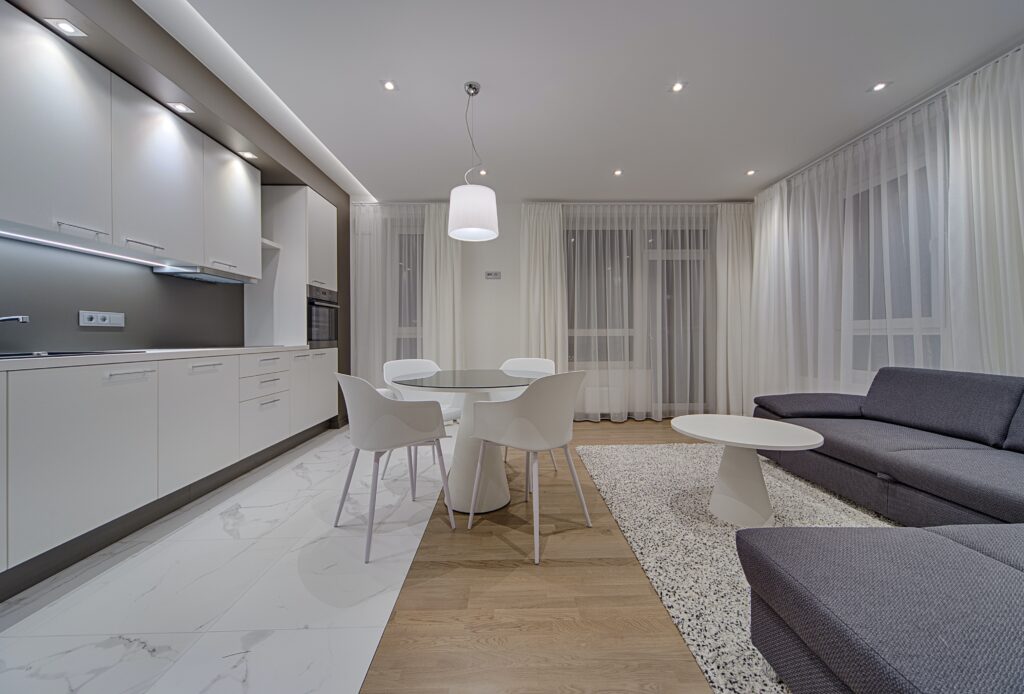Smart home: device definition, advantages and disadvantages
What is a smart home?
A smart home is a home that uses various devices, gadgets, and appliances that are connected to the internet and can be controlled remotely or automatically. A smart home can offer convenience, efficiency, security, and comfort to its residents.
How smart homes work
Smart homes work by using different protocols and technologies to communicate between devices. Some of the common protocols are Wi-Fi, Bluetooth, Zigbee, and Z-Wave. These protocols allow devices to send and receive signals and data over the internet or a local network.
A smart home also needs a central hub or a bridge that connects all the devices and acts as a gateway to the internet. A hub can be a smart speaker, a smartphone app, or a dedicated device. A hub allows users to control and monitor their smart devices using voice commands, touch screens, or mobile apps.
Smart home systems

There are many types of smart home systems that can enhance various aspects of home life. Some of the popular smart home systems are:
- Smart lighting: Smart lighting solutions allow users to adjust the brightness, color, and schedule of their lights using their smartphones or voice assistants. Smart lighting can also create different moods, scenes, and routines for different occasions.
- Smart entertainment: Smart entertainment devices include smart TVs, speakers, soundbars, streaming devices, and gaming consoles. These devices can provide access to various online content and services, such as Netflix, Spotify, YouTube, and more. Users can also control these devices using voice commands or mobile apps.
- Smart appliances: Smart appliances include smart refrigerators, ovens, coffee makers, dishwashers, washing machines, and more. These appliances can be controlled remotely or automatically and can provide useful information and feedback to users. For example, a smart refrigerator can notify users when they are running low on groceries or suggest recipes based on the available ingredients.
- Smart utilities: Smart utilities include smart thermostats, air conditioners, fans, water heaters, sprinklers, and more. These utilities can adjust their settings according to the users’ preferences, schedules, weather conditions, and occupancy. Smart utilities can also help users save energy and money by optimizing their usage and reducing wastage.
- Smart blinds: Smart blinds are window coverings that can be opened or closed automatically or remotely using sensors, timers, or mobile apps. Smart blinds can help users regulate the temperature and light in their rooms and create privacy and security.
- Smart security: Smart security devices include smart locks, doorbells, cameras, alarms, sensors, and more. These devices can provide users with real-time alerts and notifications when someone is at the door or when there is any suspicious activity in or around the home. Users can also view live or recorded footage of their home from anywhere using their smartphones or computers.

How to create a smart home
Creating a smart home can be easy and affordable with the right devices and tools. Here are some steps to follow:
- Choose a smart home ecosystem: A smart home ecosystem is a platform that integrates various smart devices and services under one umbrella. Some of the popular smart home ecosystems are Amazon Alexa, Google Assistant, Apple HomeKit, Samsung SmartThings, and IFTTT. Choosing a smart home ecosystem can help users simplify the setup and control of their smart devices and create seamless interactions between them.
- Select compatible devices: Once users have chosen a smart home ecosystem, they need to select compatible devices that work with it. Users can check the compatibility of devices by looking for logos or labels on the packaging or websites of the products. Users can also read reviews and ratings of devices online to find out their features and performance.
- Install and configure devices: After buying compatible devices, users need to install and configure them according to the instructions provided by the manufacturers. Users may need to download mobile apps or create accounts for some devices. Users may also need to connect their devices to their hub or bridge using Wi-Fi or other protocols.
- Customize settings and routines: Once users have installed and configured their devices, they can customize their settings and routines according to their needs and preferences. Users can use voice commands or mobile apps to adjust the settings of their devices manually or create schedules and rules for them to operate automatically. Users can also create scenes or modes for different situations, such as morning routine, movie night, away mode, etc.
Advantages and disadvantages of smart homes

Smart homes have many advantages and disadvantages that users should consider before investing in them. Some of the advantages are:
- Convenience: Smart homes can make life easier and more comfortable for users by allowing them to control and monitor their devices from anywhere using voice commands or mobile apps. Users can also automate their devices to perform tasks without any human intervention.
- Efficiency: Smart homes can help users save energy and money by optimizing the usage and reducing the wastage of their utilities and appliances. Users can also monitor and track their consumption and spending using smart meters and reports.
- Security: Smart homes can enhance the security and safety of users and their properties by providing them with real-time alerts and notifications when there is any suspicious activity or emergency in or around the home. Users can also remotely lock or unlock their doors, view live or recorded footage of their home, and contact authorities if needed.
- Comfort: Smart homes can improve the comfort and well-being of users by creating optimal conditions for their rooms according to their preferences, schedules, weather conditions, and occupancy. Users can also enjoy various online content and services using their smart entertainment devices.
Some of the disadvantages are:
- Cost: Smart homes can be expensive to set up and maintain, depending on the number and quality of devices and services involved. Users may need to buy new devices or upgrade their existing ones to make them compatible with their smart home ecosystem. Users may also need to pay for subscriptions or fees for some services or features.
- Privacy: Smart homes can pose a risk to the privacy and personal data of users, as they collect and store various information about their habits, preferences, activities, and locations. Users may need to share this information with third-party companies or platforms that provide or support their smart devices and services. Users may also be vulnerable to hacking or cyberattacks that could compromise their devices or data.
- Reliability: Smart homes can be unreliable or malfunctioning due to various factors, such as power outages, internet disruptions, software bugs, hardware failures, or human errors. Users may face difficulties or inconveniences when their devices do not work as expected or when they lose connection or control over them.
How much does a smart home cost

The cost of a smart home can vary depending on the type and number of devices and services involved. According to a report by HomeAdvisor, the average cost of installing a smart home system in the US is $1,392, with a typical range of $598 to $2,186. However, this cost does not include the price of individual devices or services, which can range from $10 to $1,000 or more per item.
Some factors that can affect the cost of a smart home are:
- The size and layout of the home: Larger and more complex homes may require more devices and wiring to cover all the areas and functions.
- The compatibility and integration of devices: Devices that are compatible with each other and with a common hub or bridge may be easier and cheaper to install and operate than devices that require separate hubs or bridges or that do not work well together.
- The features and functionality of devices: Devices that offer more features and functionality may be more expensive than devices that offer basic features and functionality.




